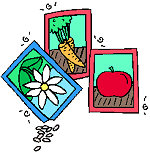Starting your
Garden
 When it comes to gardening, gardeners are of two minds.
Some gardeners prefer to buy young seedlings and transplant
them in the garden. For one thing,
although transplanting seedlings can provide a good head
start for the gardener, it can also introduce problems like
disease or insect infestation to an established garden plot.
Environmentally friendly young plants can be purchased from
local merchants to ensure better quality. Another option
if you have a healthy garden started, is plant propagation
from stem cuttings. Stems, roots and leaves can be used,
depending on the type of plant.
When it comes to gardening, gardeners are of two minds.
Some gardeners prefer to buy young seedlings and transplant
them in the garden. For one thing,
although transplanting seedlings can provide a good head
start for the gardener, it can also introduce problems like
disease or insect infestation to an established garden plot.
Environmentally friendly young plants can be purchased from
local merchants to ensure better quality. Another option
if you have a healthy garden started, is plant propagation
from stem cuttings. Stems, roots and leaves can be used,
depending on the type of plant.
Other gardeners prefer the control and
the sense of accomplishment that comes with planting flowers
and plants directly from seeds. The organic seed market is
a recent development. Seed catalogs are also good source for
organic seeds. If you are having problems finding organic,
you could consider growing seed from your own plants. So in seed selection the entire plant is to be considered.
Is it sturdy, strong, well shaped and symmetrical; does it
have a goodly number of fine blossoms? These are questions
to ask in seed selection.
Planting from seed helps gardeners to avoid these problems.
It is not difficult to plant from seed, but it is vital
to read and follow the instructions on the seed packet for
best results. It is also important
to protect the seeds and the delicate seedlings as they
grow.
Whenever you plant seeds, it is a good idea to use a quality
growing tray. It is important to choose the right growing
tray, and you can get recommendations from your local nursery
or garden center on the best type of tray for your needs.
After you have the tray and the seeds in hand, the next
step is to fill that growing tray with a high quality seed
mixture. This type of product is also called a seed starting
mix, and it is similar in consistency to potting soil. Another
advantage of the seed starting mix is that it is sterile,
and free of diseases and garden pests. There are now more
organic potting soil mixes to choose from.
After the growing tray has been prepared, the seeds should
then be placed in the seed starting mix. The rule of thumb
when planting seeds is to plant them at least twice their
own depth. In some cases, such as with very small seeds,
you may want to simply dust the seeds with a light coating
of seed mix, since if they are buried too deep they may
not be able to sprout.
After the seeds have been planted in the tray, they should
be labeled, using either sticks printed with a waterproof
marker or actual nursery labels. Do not use the seed packets
as labels, since they will quickly disintegrate from moisture
as the seeds are watered.
Only a misting sprayer should be used to provide water
to the newly planted seeds. If you use a hose or watering
can, you could inadvertently dislodge the seed medium or
uncover the seeds. The growing tray should be covered in
order to prevent the moisture from evaporating. A covered
tray will also encourage the germination of the seeds.
Another thing that can speed up the germination of newly
planted seeds is heat. Heat has been shown to speed up the
germination of seeds, and this is a technique used by many
successful gardeners. Another favorite technique of gardeners
is to use a bell jar to protect delicate seedlings from
late frost. If bell jars cannot be found, a regular water
bottle with the bottom cut off makes a good replacement.



